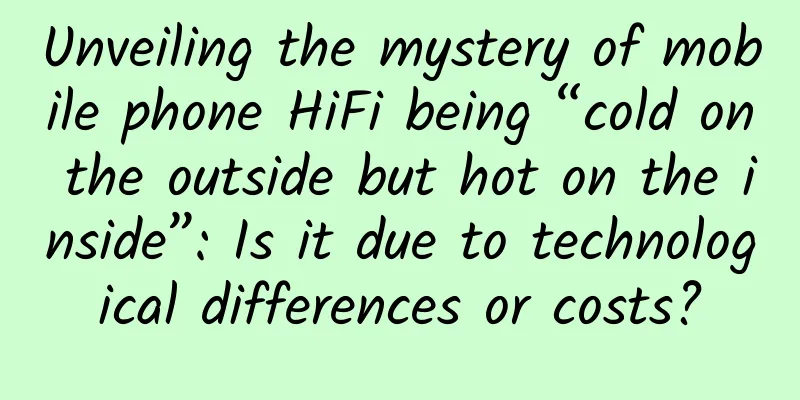Unveiling the mystery of mobile phone HiFi being “cold on the outside but hot on the inside”: Is it due to technological differences or costs?

|
"HiFi mobile phone" - when hearing this term, some friends can immediately think of several names of mobile phones that are hot-selling on the market. Specifically, the so-called HiFi mobile phone is a mobile phone that uses some more advanced chips or circuit designs in the audio decoding or amplification part to achieve a better listening experience than conventional designs. So far, domestic brands have made a name for themselves in the field of HiFi mobile phones, so that "whether it is HiFi" and "whether it has independent audio design" have become technical standards that some users value when choosing mobile phones. With the market's pursuit of mobile phone HiFi, we see that more and more domestic mobile phones are beginning to promote HiFi as an important selling point... Even the pursuit of independent DAC models and specifications has the momentum of the "nuclear war" of mobile phone main control in the past... However, in sharp contrast, many flagship mobile phones of international brands do not seem to take "HiFi hardware" so seriously: Samsung's S7, SONY's XZ, HTC's HTC10, and of course, the Apple 7 and 7P do not promote whether they have HiFi-related circuits - is it that foreigners don't like to listen to music? Or do these international brands not pay attention to sound quality, or are they not as good as domestic manufacturers in technology? What is "Mobile HiFi"? To understand the different attitudes of domestic and foreign manufacturers towards "HiFi design", we must first understand what "HiFi" is and how it is implemented on mobile phones. HiFi, the full name of High fidelity, was first proposed in 1940 as a subjective concept of "purity". In 1966, West Germany DIN (German Institute for Standardization) formulated DIN 45500 as a quantitative standard for high fidelity. In fact, the concept of high fidelity was not originally applicable to music. People associated it with audio technology after the emergence of CD and DAP (digital audio tape). Nowadays, it is generally believed that for mobile devices or Walkmans, as long as their theoretical sound quality (frequency response range, signal-to-noise ratio) can reach the level of CD, it can be called HiFi. According to this standard, in fact, all current mid-to-high-end mobile phones can achieve CD-level sound quality as long as they do not deliberately make mistakes in circuits or sound effects, and can be considered HiFi. So, what is the significance of those mobile phones that claim to have "HiFi design"? First of all, everyone should understand that the playback of music must go through the complete process of sound source (music file or online streaming) - decoding - amplification - output to headphones - the sound emitted by the headphones is received by the human ear. Most HiFi mobile phones have hardware enhancements in the decoding and amplification parts, and have higher processing accuracy than the "original" chip of SoC (mobile phone main control). But the problem is: if the user does not have HiFi-level music files (mp3 is definitely not counted) and does not have good enough headphones, even if the mobile phone audio hardware is better, it is actually meaningless. Moreover, the original meaning of "HiFi" is "original sound reproduction" - more advanced audio hardware will never make low-quality song files sound better, it is just the opposite, it will only make the sound quality loss in the ripping process sound more obvious and more unpleasant... Without HiFi mobile phones, how do foreigners listen to music? Of course, some people will definitely say: Even if we don't have HiFi sound sources, at least the sound quality of mobile phones is better; even if foreigners have genuine digital sound sources with better sound quality, but the mobile phone does not have HiFi design, the final listening experience will not be too good, right? Unfortunately, it is not - the reason is very simple, because for most mobile phone users abroad, although they pay for genuine albums from Apple Music and Google Play, the online listening experience of these platforms is also only slightly better than that of mp3 - ordinary mobile phones are already enough to handle it, and HiFi mobile phones will not turn decay into magic. For those real music enthusiasts, "bundling" external decoders/amplifiers on mobile phones, or using more professional high-quality portable players instead of mobile phones is the best way: no matter how advanced HiFi mobile phones are, their built-in audio circuits only account for a small part of the cost of the mobile phone and the area of the circuit board, and cannot be compared with the sound quality level of external decoders. So, are overseas brands lazy for not doing HiFi? At least in my opinion, not doing "integrated HiFi stacking" does not mean that they have not paid attention to sound quality and listening experience: in fact, whether it is Samsung or SONY, their mobile phones have integrated a class of functions that are very meaningful to ordinary users - compressed sound quality repair algorithms. On SONY, the algorithm is called DSEE (the new version is DSEE HX), and Samsung calls it UHQ (U-quality original sound). Their functions are to use complex calculations to make mp3-level music files "regenerate" a detailed listening experience that is close to or even exceeds that of CDs. For ordinary mobile phone users, such algorithms are actually more practical than HiFi hardware. Secondly, the author noticed that the flagship phones of SONY, ASUS and HTC all claim to have passed the "Hi-Res" certification (commonly known as the small gold label): this does not mean that they "can play" 24-bit 96KHz audio files. Hi-Res certification requires that the signal at the final output of the device must also reach a level sufficient to reflect high-resolution audio in terms of specifications. In other words, these mobile phones may not use any special "chip" design, but the output response frequency and signal-to-noise ratio of its actual headphone jack have long surpassed the HiFi level and reached a higher level. "HiFi mobile phone": a transitional product under the general environment It is undeniable that manufacturers dare to innovate and make original HiFi circuit designs on mobile phones, which is a reflection of their imagination and design level. However, in terms of the actual experience of users, mobile phones at this stage do not need advanced and expensive HiFi components to achieve HiFi sound quality. And mobile phones using HiFi components cannot actually play their strength if users do not have good sound sources and good headphones. In my opinion, mobile games and online music listening are popular in China nowadays. Mobile phones have "replaced" handheld game consoles and walkmans to a certain extent. This is not an advanced embodiment, but a helpless choice caused by limited consumption levels and unwillingness to pay for content. At least, from the perspective of the final user experience, you can't play a full-score masterpiece like "Zelda: Breath of the Wild" on your mobile phone, and the sound quality of expensive HiFi mobile phones may be far inferior to a 100-yuan machine plus a bundled decoder of several hundred yuan and a genuine Hi-Res album of dozens of yuan... HiFi mobile phones are not "feverish": whether for ordinary users or professional music lovers, it is not the best choice. But it has played a good role in popularizing and paving the way for the whole nation to improve its music appreciation level, and is a qualified transitional product. As a winner of Toutiao's Qingyun Plan and Baijiahao's Bai+ Plan, the 2019 Baidu Digital Author of the Year, the Baijiahao's Most Popular Author in the Technology Field, the 2019 Sogou Technology and Culture Author, and the 2021 Baijiahao Quarterly Influential Creator, he has won many awards, including the 2013 Sohu Best Industry Media Person, the 2015 China New Media Entrepreneurship Competition Beijing Third Place, the 2015 Guangmang Experience Award, the 2015 China New Media Entrepreneurship Competition Finals Third Place, and the 2018 Baidu Dynamic Annual Powerful Celebrity. |
>>: Digital camera sales hit a new low, replaced by smartphones
Recommend
Two key points to achieve a 60% private domain repurchase rate
A few days ago, a good friend and I walked to the...
How to get users to try your new product? Here are 5 tips!
A while ago, a new coffee shop opened downstairs ...
Apple's secret to success: Don't be the first to strike back
[[137238]] Apple sold more than 61 million iPhone...
Summary of Through Train Promotion Skills
1. About Through Train If you want to do a good j...
Light and Shadow No. 7-Ae+C4D Business Advanced Case Course Master Class (First Period)
Light and Shadow No. 7-Ae+C4D Business Advanced C...
How to do investment advertising?
Nowadays, investment promotion advertisements are...
The commercial capital impulse behind the popularity of shared home appliances
As a new business outlet in the Internet era, the...
The secrets of the No.1 public and private domain traffic gameplay in the category revealed!
In the era of inventory, merchant brands should t...
If robots keep doing this, screenwriters will all be out of work.
Humans have a variety of creativity. Recently, AI...
A brief discussion on Weibo marketing and promotion strategies!
Weibo may not bring direct sales, but it can subt...
China Association of Automobile Manufacturers: Brief analysis of automobile industry production and sales in July 2023
According to statistics and analysis by the China...
How to break the "medical addiction"? Uncovering the strange baron behind "Munchausen syndrome"
Leviathan Press: Seeing Munchausen syndrome, it i...
How much does it cost to develop a mini program? How much does it cost to make a mini program?
With the rapid development of the Internet, mini ...
Is information flow advertising ineffective? Maybe you didn’t choose the right promotion channel!
In the past, educational institutions’ promotiona...
In-depth | Talk about the operational strategy of AARRR model in e-commerce marketing activities
The " AARRR Model " is a concept mentio...









